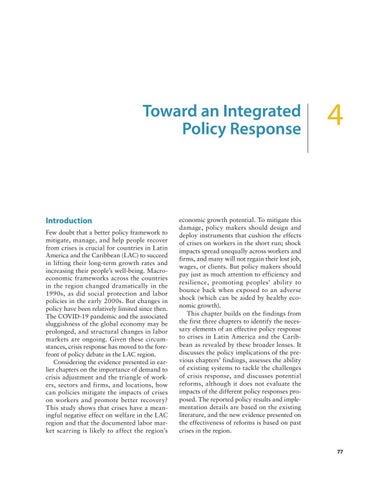Toward an Integrated Policy Response
Introduction Few doubt that a better policy framework to mitigate, manage, and help people recover from crises is crucial for countries in Latin America and the Caribbean (LAC) to succeed in lifting their long-term growth rates and increasing their people’s well-being. Macroeconomic frameworks across the countries in the region changed dramatically in the 1990s, as did social protection and labor policies in the early 2000s. But changes in policy have been relatively limited since then. The COVID-19 pandemic and the associated sluggishness of the global economy may be prolonged, and structural changes in labor markets are ongoing. Given these circumstances, crisis response has moved to the forefront of policy debate in the LAC region. Considering the evidence presented in earlier chapters on the importance of demand to crisis adjustment and the triangle of workers, sectors and firms, and locations, how can policies mitigate the impacts of crises on workers and promote better recovery? This study shows that crises have a meaningful negative effect on welfare in the LAC region and that the documented labor market scarring is likely to affect the region’s
4
economic growth potential. To mitigate this damage, policy makers should design and deploy instruments that cushion the effects of crises on workers in the short run; shock impacts spread unequally across workers and firms, and many will not regain their lost job, wages, or clients. But policy makers should pay just as much attention to efficiency and resilience, promoting peoples’ ability to bounce back when exposed to an adverse shock (which can be aided by healthy economic growth). This chapter builds on the findings from the first three chapters to identify the necessary elements of an effective policy response to crises in Latin America and the Caribbean as revealed by these broader lenses. It discusses the policy implications of the previous chapters’ findings, assesses the ability of existing systems to tackle the challenges of crisis response, and discusses potential reforms, although it does not evaluate the impacts of the different policy responses proposed. The reported policy results and implementation details are based on the existing literature, and the new evidence presented on the effectiveness of reforms is based on past crises in the region.
77

